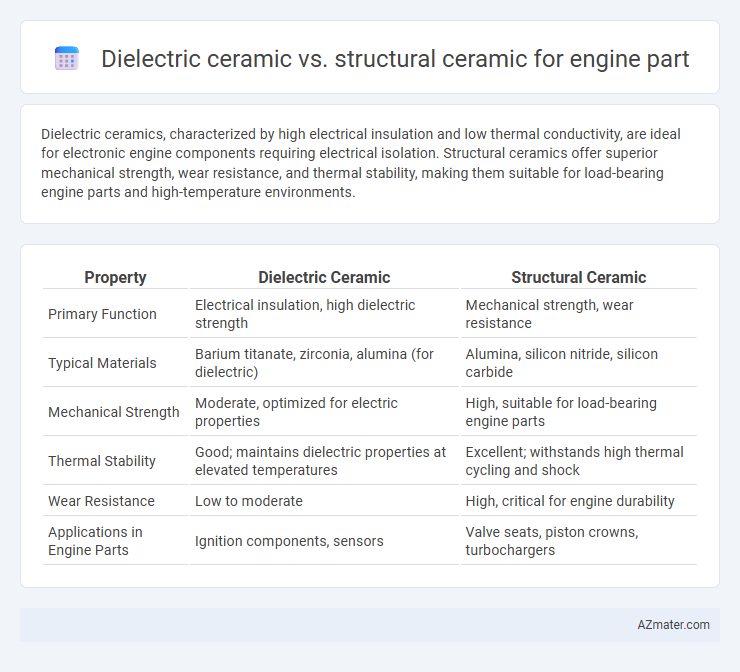Dielectric ceramics, characterized by high electrical insulation and low thermal conductivity, are ideal for electronic engine components requiring electrical isolation. Structural ceramics offer superior mechanical strength, wear resistance, and thermal stability, making them suitable for load-bearing engine parts and high-temperature environments.
Table of Comparison
| Property | Dielectric Ceramic | Structural Ceramic |
|---|---|---|
| Primary Function | Electrical insulation, high dielectric strength | Mechanical strength, wear resistance |
| Typical Materials | Barium titanate, zirconia, alumina (for dielectric) | Alumina, silicon nitride, silicon carbide |
| Mechanical Strength | Moderate, optimized for electric properties | High, suitable for load-bearing engine parts |
| Thermal Stability | Good; maintains dielectric properties at elevated temperatures | Excellent; withstands high thermal cycling and shock |
| Wear Resistance | Low to moderate | High, critical for engine durability |
| Applications in Engine Parts | Ignition components, sensors | Valve seats, piston crowns, turbochargers |
Introduction to Ceramic Materials in Engine Parts
Dielectric ceramics, characterized by their excellent electrical insulation and thermal stability, are primarily used in engine parts requiring high dielectric strength and resistance to electrical currents. Structural ceramics offer superior mechanical properties such as high hardness, wear resistance, and fracture toughness, making them ideal for components subjected to extreme stress and temperatures in engine environments. Understanding the distinct functional roles of dielectric versus structural ceramics helps optimize engine performance, durability, and efficiency by selecting materials tailored to specific operational demands.
Overview of Dielectric Ceramics
Dielectric ceramics, characterized by their excellent electrical insulating properties and high dielectric strength, are primarily used in engine parts requiring minimal electrical conductivity and resistance to high temperatures. These materials, such as alumina and zirconia, provide exceptional thermal stability and corrosion resistance while preventing electrical interference in sensitive engine components. In contrast, structural ceramics focus on mechanical strength and wear resistance, making dielectric ceramics ideal for applications where electrical insulation and thermal performance are critical.
Overview of Structural Ceramics
Structural ceramics for engine parts exhibit exceptional hardness, high compressive strength, and excellent thermal stability at elevated temperatures, making them ideal for applications involving wear resistance and mechanical load bearing. These ceramics, such as silicon nitride and alumina, provide superior fracture toughness and corrosion resistance compared to dielectric ceramics, which primarily focus on electrical insulation properties. The ability of structural ceramics to maintain dimensional stability and resist thermal shock enables improved engine efficiency and durability under extreme operational conditions.
Key Material Properties Comparison
Dielectric ceramics for engine parts excel in electrical insulation and high thermal stability, making them ideal for applications requiring minimal electrical conductivity and resistance to thermal shock. Structural ceramics offer superior mechanical strength, fracture toughness, and wear resistance, which are critical for load-bearing engine components exposed to high stress and abrasive environments. Comparing these materials reveals dielectric ceramics prioritize electrical and thermal insulation properties, whereas structural ceramics are optimized for mechanical durability and longevity under extreme operational conditions.
Thermal Resistance and Stability
Dielectric ceramics exhibit excellent thermal resistance due to their low thermal conductivity and high insulating properties, making them suitable for engine parts exposed to electrical stress and moderate temperatures. Structural ceramics offer superior thermal stability and mechanical strength, maintaining integrity under extreme temperature fluctuations and high mechanical loads typical in engine combustion environments. The choice between dielectric and structural ceramics depends on balancing electrical insulation needs with the requirement for thermal shock resistance and mechanical durability in engine components.
Mechanical Strength and Durability
Dielectric ceramics used in engine parts offer excellent electrical insulation but generally have lower mechanical strength and durability compared to structural ceramics, which are engineered to withstand high stress, temperature, and wear. Structural ceramics such as silicon nitride and alumina provide superior fracture toughness, thermal shock resistance, and long-lasting performance in harsh engine environments. The enhanced mechanical properties of structural ceramics make them ideal for critical components subjected to cyclic loads and mechanical impact.
Electrical Insulation Capabilities
Dielectric ceramics exhibit superior electrical insulation capabilities compared to structural ceramics, making them ideal for engine parts requiring high voltage resistance. Structural ceramics prioritize mechanical strength and thermal stability, often sacrificing electrical insulation properties. Therefore, dielectric ceramics are preferred in applications where preventing electrical conductivity and ensuring insulation under harsh engine conditions are critical.
Common Applications in Engine Components
Dielectric ceramics are commonly used in engine components such as spark plug insulators and sensors, where electrical insulation and high dielectric strength are critical for reliable signal transmission and ignition performance. Structural ceramics, including silicon nitride and alumina, serve in engine parts like valve components, turbocharger rotors, and piston rings due to their exceptional hardness, high-temperature resistance, and wear resistance, enhancing engine durability and efficiency. The selection between dielectric and structural ceramics depends on electrical insulation needs versus mechanical strength and thermal stability in specific engine applications.
Performance Challenges and Limitations
Dielectric ceramics used in engine parts offer excellent electrical insulation and high-temperature stability but suffer from brittleness and limited mechanical strength under dynamic loads. Structural ceramics provide superior mechanical properties such as high hardness and wear resistance, yet they face challenges related to fracture toughness and thermal shock resistance in the harsh engine environment. Balancing these performance limitations is critical for optimizing engine component reliability and durability.
Future Trends in Ceramic Engine Materials
Dielectric ceramics for engine parts offer superior electrical insulation and thermal stability, critical for advanced sensor integration and electronic control units in next-generation engines. Structural ceramics provide exceptional mechanical strength, wear resistance, and high-temperature performance, making them ideal for components exposed to extreme thermal and mechanical stresses. Future trends emphasize hybrid ceramic composites that combine dielectric and structural properties, enhancing engine efficiency, durability, and enabling smart engine systems through embedded sensing and self-monitoring capabilities.

Infographic: Dielectric ceramic vs Structural ceramic for Engine part
 azmater.com
azmater.com